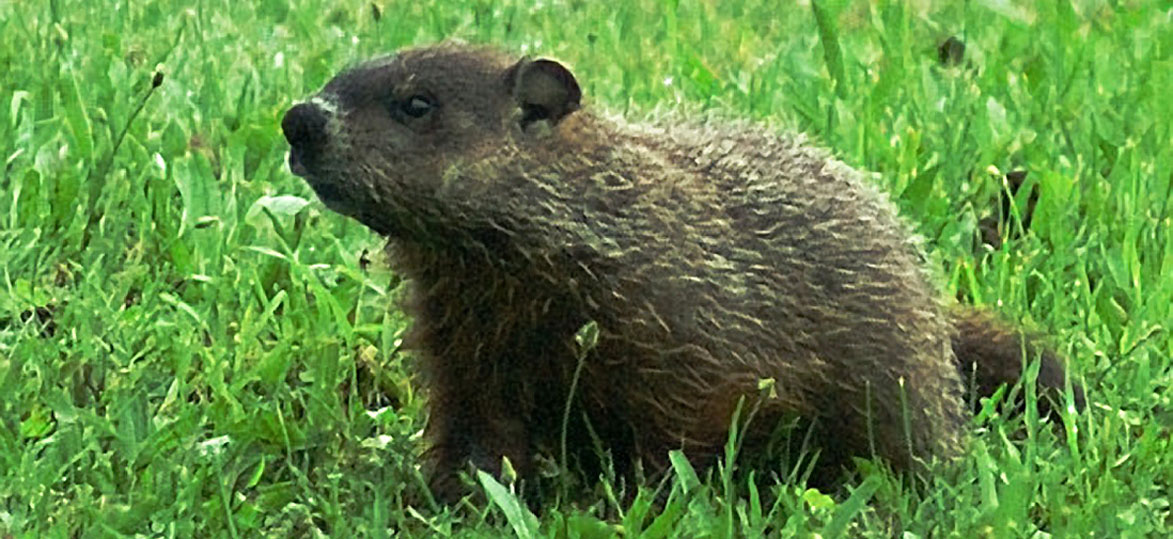
The woodchuck (Marmota monax) is known by a wide variety of names including earth pig, groundhog, and whistle pig. The name woodchuck is believed to have derived from the Cree Indian word wuchak.
The woodchuck is a medium sized rodent. It is related to the ground squirrel and marmot. It is known for its excavating ability, which allows it to create an extensive network of tunnels and burrows beneath open fields and meadows.
Farmers, gardeners, and other property owners consider the woodchuck and its tunnels a nuisance. However, this activity aerates the soil it in the process. Additionally, a wide range of animals use the woodchuck's abandoned burrows and tunnels for den sites of their own.
Habitat
The preferred habitat includes fields, pastures, meadows and open woodlands, though it is never far from cover. The woodchuck can be found in a variety of forests from coniferous to mixed or cut hardwood stands.
As the woodchuck is a burrowing animal, the soil must be loose and well drained, like sandy loam. Another consideration is that the selected habitat is near a food source, such as an abundance of green vegetation or agricultural fields.
The den serves two main functions for the woodchuck. It provides a safe haven throughout the year and a place for hibernating over the winter. The woodchuck will often shift change its denning locations from season to season. It seems to prefer open areas for its denning location in the summer but more protected areas in the winter.
The underground tunnel system is quite amazing; the main entrance to a burrow may have 11 entrances, the tunnels can be up to 45 feet in length, and a large nest is located within a chamber deep inside the network of tunnels. The woodchuck keeps its den clean and well lined with grasses and dry leaves to serve as insulation.
The woodchuck is a true hibernator and depends on its fat reserve for survival. During the summer and fall, it will build up this reserve and go into hibernation in October. It will generally not emerge until March or April.
While hibernating, its metabolic processes slow down considerably with a heart rate of about 15 beats per minute, its body temperature drops from its active temp of 97 degrees F to less than 40 degrees F; and its respiration slows significantly as well.
The woodchuck is solitary. The brief mating season is only time the male and female are together. The woodchuck is diurnal, most active during the day, right after dawn and right before sunset. It also spends a considerable amount of time during the day basking in the sun. When frightened, the woodchuck produces a loud whistling sound and runs for the closest burrow. It may hiss, bark or even growl if extremely bothered by an intruder.
Reproduction
The breeding season begins in February or March, soon after they come out of hibernation. The males are polygamous, mating with more than one female, and will even fight over females during the breeding season.
Once the male and female have mated, a burrow is built and lined with vegetation to provide warmth and insulation for the young. After a short gestation period of one month, the young are born from April through May. An average litter size is between two and six young.
The young woodchucks are born defenseless, without the ability to see and lacking fur. At about four weeks of age, the kits' eyes will open and they become quite active by five weeks. They are weaned from their mother's milk around six weeks, which is also when they begin to explore outside the burrow.
The kits grow quickly and are completely independent from the female at the age of three months. At this time, the young woodchucks must quickly build up a fat to get through their winter hibernation. They generally do not become sexually active until the following spring.
Diet
The woodchuck is primarily herbivorous, with the majority of its diet consisting of plant matter. Favorites include fruits, flowers, shrubs, and succulent green vegetation such as alfalfa, clover, grasses and herbs. The woodchuck also has a taste for crops like peas, corns, beans and oats. When these food items are scarce, the woodchuck will eat bark and twigs from a variety of tree species including dogwood, sumac, and fruiting trees. It occasionally eats small insects and eggs. As most of its food is vegetables, it is considered to be a grazer. It can often be seen sitting on its haunches, or back legs, and pulling plants with its front paws to feed on.
Management
Current woodchuck populations within the state of Vermont are stable. There is no active plan designed for this species, but continued monitoring is conducted to ensure that their population remains healthy and abundant in Vermont.
Status
The woodchuck is fairly common in Vermont. It has expanded its range over the past 200 years and is a familiar animal to many.
